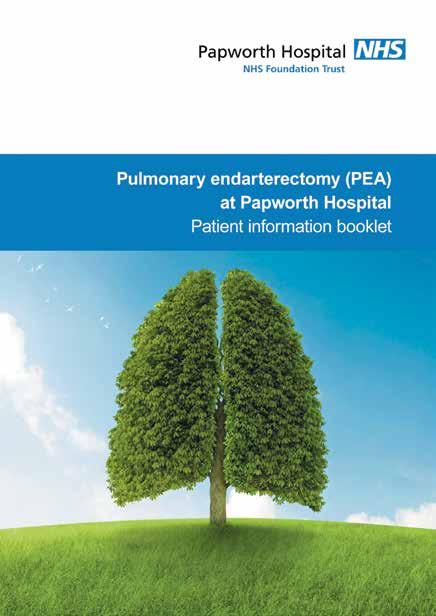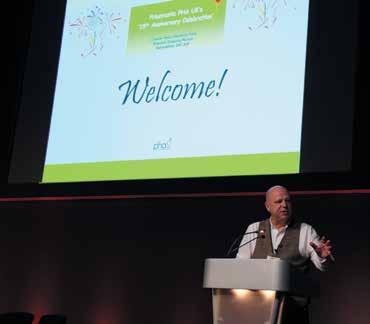
4 minute read
New surgery guide
from Emphasis Winter 2015
by PHA UK
NEW PATIENT GUIDE TO PEA SURGERY PUBLISHED Surgery is an option for a growing number of patients with a certain type of PH called Chronic Thromboembolic Pulmonary Hypertension (CTEPH). Staff at Papworth Hospital, where this operation called a Pulmonary Endarterectomy (PEA), is performed are helping patients to keep informed each step of the way through a new booklet.

The booklet has been carefully written to include all the information and guidance needed by patients and their families. A patient group reading panel from PHA UK and from Papworth has received the new material and given it a very favourable response.
Anie Ponnaberanam, lead nurse for PEA at Papworth, led the project. Anie says: “The aim was to update and expand upon a similar booklet published in 2000 using what had been learnt from the expectations and experiences of patients over the years. Input was gained from members of the team, including the retired PEA specialist nurse Maureen Rootes, consultants, surgeons and feedback from patient groups.
“The booklet explains to patients what CTEPH is and what PEA surgery involves. It covers what is likely to happen from the point of the first clinic appointment at Papworth right through to the procedure itself, recovery, and going home. Alongside detailed medical information is plenty of practical advice such as what to pack for the stay in hospital. There is also guidance for families and visitors.”
Explaining the process, Anie says: “Patients with a diagnosis of CTEPH are referred to Papworth from designated PH centres. All data and images are assessed at weekly multidisciplinary team meeting for consideration of surgery. Patients who may potentially benefit are invited to attend an out-patient clinic at Papworth for a face-to-face information session with a specialist PEA nurse and surgeon.
“The information booklet is handed to patients at their first meeting with a PEA specialist nurse at the group information session involving patients and relatives. Following this, patients will go on to have a one-to-one meeting with the nurse and then have an individual consultation with a surgeon, who will make the final decision on the operation and explain the risks and benefits of the surgery. When possible, patients may also get the opportunity to hear the first-hand experiences from an ex-patient who underwent surgery a few years ago. “The booklet compliments the face-to-face education with patients. It helps them to understand the complexity of their disease and management with surgery and guides them to give informed consent. It is a very good source of information for patients and their families to refer to at any time as they go through their journey with us. The feedback received from patients and their families so far is very positive. Patients have praised the fact it’s so detailed.".
What is CTEPH? Chronic Thromboembolic Pulmonary Hypertension is a form of PH that is caused by blockages in the blood vessels to the lungs due to scar tissue. The scars are the result of blood clots that the body has not properly cleared. These scars cause a complete or partial obstruction leading to difficulties in blood flow through the lungs. This causes high blood pressure in the lung arteries, which in turn affects the right side of the heart, which pumps blood through the obstructed lung blood vessels. The heart is forced to work harder than normal and gets bigger and weaker as it tries to cope. If left untreated, the heart will eventually start to fail. Initially people get short of breath on exertion and, with time, this could progress to shortness of breath even at rest. Patients may struggle to do any type of physical activity. Swelling of the legs and abdomen may be noticed by some patients. Treatment with blood thinning agents such as Warfarin stops more clots from forming, but has no effect on the scarring left by previous clots and has a poor prognosis without treatment. Management for CTEPH used to be a heart and lung or lung transplant, now it can be treated and potentially cured with pulmonary endarterectomy.
What are the benefits of PEA surgery? Pulmonary Endarterectomy (PEA) is potentially curative surgery to remove the scar tissue which is causing the obstruction in the lung blood vessels and can result in immediate reduction in pressure in the pulmonary artery. Most people who have operable obstructions in the big blood vessels are benefited by this surgery with improved symptoms, less breathlessness, improved quality of life and live longer after their operation. However, some people have obstructions not only in the big blood vessels that are removed by surgery, but also in smaller blood vessels that are more difficult to reach. Following surgery for these people with ‘mixed disease’ the pressure in the pulmonary artery will not completely return to normal, but their quality of life should still get better. Unfortunately, a very small number of people may not notice any benefit after surgery. If this happens, they will be closely monitored by their PH centre.
PEA at Papworth Hospital The world-famous Papworth Hospital, in Cambridgeshire, is the only hospital in the UK that carries out this specialist procedure. The first PEA surgery at Papworth Hospital was carried out by Mr John Dunning in 1997. The service was then commissioned in 2000 as Papworth Hospital NHS Foundation Trust to be the national PEA centre. Since then the service has expanded considerably in response to increasing referrals over the last 10 years. Now, there are four surgeons performing the operation. Mr David Jenkins is the lead PEA surgeon with Mr John Dunning, Mr Steven Tsui, and Mr Choo Ng. The number of patients being considered for possible surgery increases every year.










